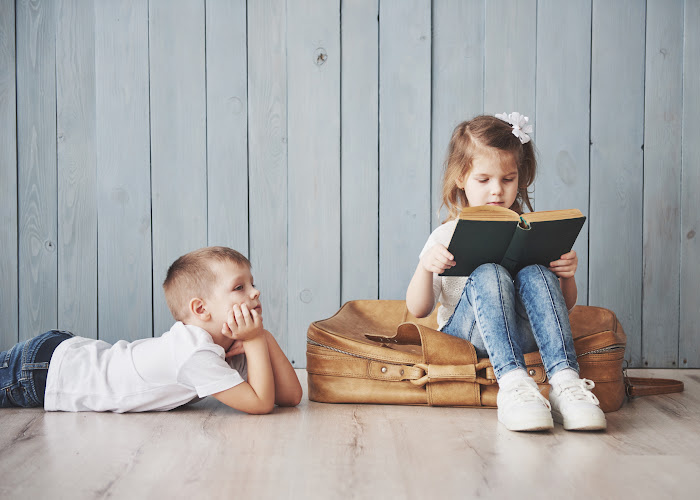Embark on a literary journey that shines a light on the rich tapestry of the…

Top Books with Autistic Main Characters to Read
Discovering books with autistic main characters can be a revelatory experience, not only for those on the autism spectrum but for readers seeking to broaden their perspectives. With a growing emphasis on neurodiversity in literature, there’s a treasure trove of narratives that invite you into the nuanced worlds shaped by autism.
The authenticity of autism representation in books has evolved, and platforms like Goodreads have curated lists that celebrate this wave of inclusive literature for autism. Spotlighting titles that provide an authentic portrayal of autism in books, readers can explore stories that move beyond stereotypes and offer heartfelt insights into diverse experiences.
As the discourse on autism acceptance in literature gains momentum, the value of these books about autism becomes ever more significant. They’re not just books; they’re portals to understanding, empathy, and celebration of the beautifully complex spectrum of human experience.

Essential Reads: Spotlight on Books with Autistic Main Characters
Delving into the world of literature reveals a treasure trove of experiences, and when it comes to autism in literature, the authenticity of representation can make a profound impact. Books with autistic main characters offer a window into the nuanced lives of individuals on the autism spectrum, providing readers with a meaningful opportunity to understand and celebrate neurodiversity.
Through the voices of neurodivergent characters in books, a richness of storytelling unfolds, an essential factor in broadening perspectives and deepening empathy.
The Impact of Authentic Portrayal in Literature
When authors with first-hand experience craft stories about autism, the result is often a more realistic and respectful depiction. Books such as “Queens of Geek” by Jen Wilde resonate with readers for just this reason, portraying characters like Tay with a genuine depth that only someone with an intimate understanding of autism can achieve. This authenticity is the cornerstone for books for understanding autism and promotes a more inclusive society that values all minds.
Young Adult Favorites and Their Resonance
The influence of young adult fiction in shaping attitudes is undeniable, especially when dealing with topics like neurodiversity. Tay’s journey in “Queens of Geek” and Eve Brown’s adventures in “Act Your Age, Eve Brown” by Talia Hibbert offer relatable experiences for readers young and old. These narratives contribute significantly to the broader conversation, addressing fears, dreams, and the everyday moments of life with autism, strengthening the representation of diverse books with autistic characters.
Celebrating Neurodiversity Through Fiction
“The Many Half-Lived Lives of Sam Sylvester” by Maya MacGregor is another illuminating example, providing rich and varied experiences of individuals on the spectrum. These stories invite readers to join in a collective celebration of difference, where autistic characters are fully realized individuals, leading lives that are so much more than a single aspect of their identity. As part of the fabric of society, these narratives uplift and spotlight neurodivergent characters in books, opening doors to greater acceptance and understanding.
The titles mentioned are just the beginning. There’s a wealth of literature waiting to be explored, each book providing its own unique take on what it means to live an autistic life. During #autismacceptancemonth and beyond, these essential reads not only entertain but also educate, fostering a more accepting and inclusive world, one story at a time.

Understanding Autism Through Fiction: A Dive into Character Development
Fiction offers a unique lens through which we can gain insight into autism, a spectrum filled with diverse experiences and perspectives. Through careful character development and immersive storytelling, books about autism not only entertain but also educate and foster empathy.
Let’s explore some renowned titles that provide rich portrayals of autism, the nuances of neurodiversity in literature, and contribute to autism representation in books.
“The Rosie Project” by Graeme Simsion introduces us to Don Tillman, an unforgettable character whose methodical approach to finding love is as endearing as it is enlightening, underscoring the often-humorous yet complex nature of autism.
“The Kiss Quotient” series by Helen Hoang features protagonists with autism navigating their personal and romantic lives, breaking down stereotypes by showcasing depth, growth, and the multifaceted aspects of neurodiversity.
“Rules” by Cynthia Lord and “Counting by 7s” by Holly Goldberg Sloan delve into the experiences of younger characters, offering a lens into the everyday triumphs and challenges faced by individuals on the autism spectrum.
Inclusive literature for autism draws readers into the inner worlds of their protagonists, creating spaces for understanding that transcend the pages. As we embrace these narratives, we champion a more inclusive and compassionate world, where the beauty of neurodiversity is both recognized and celebrated.
By reaching for these stories, we bridge gaps and build connections, making literature a powerful ally in the quest for heightened acceptance. Whether you are intimately familiar with autism or are seeking to understand it better, these books serve as gateways to richer, more inclusive conversations about the diversity of human experience.
Books with Autistic Main Characters: A List of Must-Reads
Diving into the world of literature reveals a treasure trove of stories that bring the experiences of neurodivergent characters to the forefront. The books highlighted here provide readers with a variety of genres, each offering a meaningful exploration of life from an autistic perspective. Not only do they contribute to a deeper understanding of autism, but they also showcase authentic portrayals and promote autism acceptance in literature.
Contemporary Novels Featuring Autistic Protagonists
Contemporary literature opens a window into the everyday lives of individuals with autism, inviting readers to experience their world. Novels such as Ann M. Martin’s “Rain Reign,” which tells the poignant story of a young girl’s connection with her dog, provide not just a touching narrative, but also insight into the autistic experience. Similarly, “The Remains of the Day” by Kazuo Ishiguro, though not centered solely on autism, includes a protagonist with traits reflective of autism, offering a subtle exploration of the neurodivergent mind within the context of a historical narrative.
Mystery and Adventure with Autistic Leads
For those who enjoy unraveling puzzles and embarking on thrilling journeys, books such as “The Rosie Effect” by Graeme Simsion and “Extremely Loud & Incredibly Close” by Jonathan Safran Foer present adventures led by captivating autistic characters. These stories blend excitement and introspection, showing that neurodivergent characters can be as heroic and compelling as any other.
Inclusive Romances: Finding Love and Acceptance
Romantic narratives often explore the complexities of human relationships, and when featuring neurodivergent protagonists, they shine a light on the diverse ways love can manifest. “The Kiss Quotient” series and “The Girl He Used To Know” by Tracey Garvis Graves, prioritize autism representation in books, demonstrating the multifaceted nature of human connections. These inclusive romances provide a refreshing take on the genre, delivering stories of acceptance and genuine connection.

Conclusion
As we delve into the vast mosaic of literacy, we recognize that books with autistic main characters are not just narratives, they are pivotal channels fostering neurodiversity in literature. The evolution within these pages exemplifies an authentic portrayal of autism in books, which, in effect, has fortified a bridge of empathy and discernment that connects readers to experiences oftentimes distant from their own.
The impact is profound, with stories spanning from the angst and aspirations of teens to the intricate emotional tapestry of adult fiction, each thread pulling the reader closer to a profound understanding of the spectrum. Through the exploration of these stories, the fabric of inclusive literature for autism grows wider, enveloping an ever-expanding audience within its warm embrace. Thus, cultivating a fertile ground for understanding autism and sowing the seeds for what is foremost – autism acceptance in literature.
The curated library we’ve discussed pays homage to an array of literary genres, each amplifying the voice of the autistic community. From the corridors of high schools illustrated in Young Adult novels to the complexities of romantic entanglements, we witness life’s multifaceted scenarios played out through the perspective of those on the spectrum. It’s clear that these tales are instrumental in shaping our social fabric through compelling narratives that advocate for inclusivity and celebration of every individual’s journey. They remind us that at the core of our humanity lies a shared desire for connection, one that is enriched by the beauty and breadth of neurodiversity.
FAQ
What are some recommended books with autistic main characters?
Highly recommended titles include “The Curious Incident of the Dog in the Night-Time” by Mark Haddon, “The Rosie Project” by Graeme Simsion, “Mockingbird” by Kathryn Erskine, and “Rules” by Cynthia Lord. Works by actually autistic authors, like “Queens of Geek” by Jen Wilde and “The Many Half-Lived Lives of Sam Sylvester” by Maya MacGregor, among others, offer an authentic portrayal of autism in books.
How do books contribute to autism representation in literature?
Books with autistic main characters allow for a range of stories that can show the depth and variety of autistic experiences. They contribute by providing authentic portrayals, which enhance understanding and acceptance of neurodiversity in our society.
What genres can be found when looking for books about autism?
You will find a spectrum of genres, including young adult narratives, contemporary fiction, mystery, adventure, and inclusive romances, all featuring autistic protagonists.
Why is it important to have an authentic portrayal of autism in books?
Authentic portrayals in literature help to combat stereotypes and misconceptions by providing a more accurate and nuanced view of what it means to be autistic. They foster empathy and understanding, contributing to a more inclusive society.
Can you recommend some young adult books with autistic main characters?
Yes, young adult favorites include “Queens of Geek” by Jen Wilde, “Act Your Age, Eve Brown” by Talia Hibbert, and “The Many Half-Lived Lives of Sam Sylvester” by Maya MacGregor. These books have resonated well with readers for their relatable and nuanced depictions of autistic characters.
What are some books that celebrate neurodiversity through fiction?
“The Kiss Quotient” by Helen Hoang, “The Speed of Dark” by Elizabeth Moon, and “Counting by 7s” by Holly Goldberg Sloan are excellent books that celebrate neurodiversity and offer engaging stories where autism is a part of the character’s identity.
Are there mystery or adventure books that feature autistic leads?
Yes, “The Curious Incident of the Dog in the Night-Time” by Mark Haddon and “Extremely Loud & Incredibly Close” by Jonathan Safran Foer are thrilling reads with autistic protagonists embarking on mysterious or adventurous journeys.
Can you suggest some inclusive romances featuring autistic characters?
“The Rosie Project” by Graeme Simsion, “The Kiss Quotient” series by Helen Hoang, and “The Girl He Used To Know” by Tracey Garvis Graves are all romances that offer inclusive portrayals of love and acceptance, featuring autistic main characters.
How do books with autistic characters help in understanding autism?
These books open a window into the diverse experiences of individuals on the autism spectrum. Through storytelling and character development, readers gain insight into the challenges and triumphs of autistic characters, which helps in fostering understanding and empathy.
What are some essential reads for learning about autism acceptance in literature?
Essential reads that promote autism acceptance include “The Reason I Jump” by Naoki Higashida, “The Speed of Dark” by Elizabeth Moon, and “Thinking in Pictures” by Temple Grandin. These books advocate for the appreciation of neurodiversity and convey the importance of accepting autistic individuals as they are.



This Post Has 0 Comments